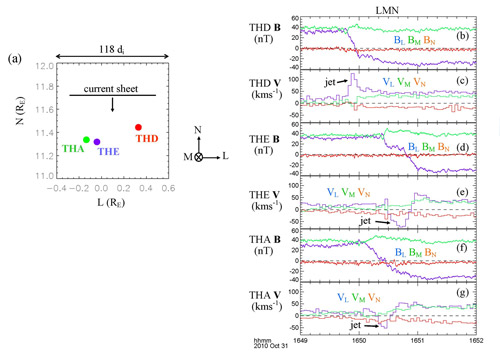
2017 THEMIS SCIENCE NUGGETS
THEMIS multispacecraft observations of a reconnecting magnetosheath current sheet with symmetric boundary conditions and a large guide field
by Marit Øieroset
Space Sciences Laboratory, UC Berkeley
Introduction
Magnetic reconnection is a universal energy conversion process that converts magnetic energy into kinetic energy. During reconnection, anti-parallel magnetic field lines break and reconnect in a small region surrounding a magnetic X-line, resulting in large-scale changes in the magnetic topology and bi-directional outflow jets.
The majority of in situ spacecraft observations of reconnection have been made in the Earth’s magnetosphere. However, the magnetosheath, a region of shocked solar wind plasma downstream of the Earth’s bow shock, is also an ideal place for reconnection observations. Reconnection can be initiated in the magnetosheath due to compression of solar wind current sheets at the bow shock and against the dayside magnetopause.
We here report the first multi-spacecraft observations of bi-directional reconnection jets in a magnetosheath current sheet. The two diverging exhausts displayed significant differences, and we attribute the differences to the presence of a magnetic island/flux rope on one side of the X-line and a regular, open ended, exhaust on the other side. The outflow profile across the exhaust suggests that the island/flux rope was formed by two active X-line formed at different times, where the outflow from one X-line wraps around the outflow from the other X-line (Figure 1).
| Figure 1. Cartoon showing how reconnection jets can wrap around each other when two X–lines form at different times. Approximate THEMIS spacecraft trajectories through the current sheet are indicated with the dashed vertical lines. |
Observations
Figure 2a shows the locations of the three THEMIS spacecraft projected onto the L-N plane. The horizontal line and the vertical arrow illustrate how the current sheet moved past the three spacecraft. L is along the reconnecting field direction, N is normal to the current sheet, and M is along the X-line.
The spacecraft observations are shown in Figure 2b-g. The current sheet, seen as a reversal in the BL component (in blue), was first encountered by THEMIS-D (THD), then by THEMIS-A (THA), and finally by THEMIS-E (THE). During the current sheet crossing THD observed a positive VL jet, while THA and THE observed a negative VL jet at the current sheet midplane (BL=0). The relative positions of the spacecraft imply that the VL jets were diverging, indicating the presence of a reconnection X-line between THD and THA/THE.
| Figure 2. Global hybrid simulation (ANGIE3D) result of ion temperature distribution in the x-z plane of the magnetotail averaged over -10R_E≤y≤10R_E at a representative time, t=1430s. |
The VL jet structures were different on the two sides of the X-line. While the THD jet was unidirectional throughout the exhaust, the dominant negative VL jet at the midplane observed by THE and THA was flanked by two weaker positive flows at the edges of the exhaust. This tripolar jet profile suggests that a second X-line could be present, giving rise to positive VL flows at the edges at THE/THA. This situation is illustrated in Figure 1.
Conclusion
Three THEMIS spacecraft have recorded the detailed plasma and field profiles in two diverging reconnection exhausts in a magnetosheath current sheet. The observed exhaust profiles suggest that THD observed an open-ended exhaust, while THE/THA crossed a magnetic island/flux rope between two active X-lines.
Reference
Øieroset, M., T. D. Phan, M. A. Shay, C. C. Haggerty, M. Fujimoto, V. Angelopoulos, J. P. Eastwood, and F. S. Mozer (2017), THEMIS multispacecraft observations of a reconnecting magnetosheath current sheet with symmetric boundary conditions and a large guide field, Geophys. Res. Lett., 44, doi:10.1002/2017GL074196.Biographical Note
Marit Øieroset is a Research Physicist at the Space Sciences Laboratory at UC Berkeley, where she currently studies spacecraft observations from THEMIS and MMS. Her main research interest is the magnetic reconnection process in space plasmas.
 Please send comments/suggestions to
Emmanuel Masongsong / emasongsong @ igpp.ucla.edu
Please send comments/suggestions to
Emmanuel Masongsong / emasongsong @ igpp.ucla.edu


